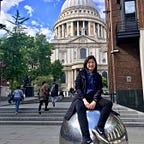Travel Notes: My Icelandic Adventure
It has been a month since my trip to Iceland and finally, I have time to sit still and reflect.
1) What is my trip about?
I joined a 12-day learning camp about the environment and photography in Iceland with a local NGO called SEEDS. Founded in 2005, SEEDS aims to promote intercultural understanding, environmental protection and awareness through work on environmental, social and cultural projects within Iceland.
In my learning camp, there is a total of 12 people from Hong Kong, Mainland China, Japan, Korea, Germany, Italy, and Portugal. Besides me, all the others are interested in sustainability but working in different fields such as chef, HR, accountant, student, designer and even DJ!
2) Key learnings
2.1 Visiting Geothermal Power Plants
1. Eight geothermal power stations in Iceland produce 30% of the country’s electricity while 70% comes from hydroelectric power stations. Iceland, therefore, produces 100% renewable electricity.
2. The geothermal heat utilization process at Hellisheiði Geothermal Power Plant has multiple by-products which are valuable for various industries.
3. The resource streams available are hot geothermal water, cold water, carbon dioxide and silica, in addition to the electricity and hot water produced at the plant.
4. By utilizing those by-products, the utilization of the resources is enhanced. As examples of utilization cool water can be used for cooling equipment, carbon dioxide is a valuable gas for enhancing greenhouse cultivation and as an ingredient for biofuel production, and silica can be used for cosmetics and food supplements.
1.2 Turning CO2 into Stone
Carbfix is a company based in Iceland that provided technologies to turn CO2 into minerals.
The company has cutting-edge technology to conduct carbon capture and injection, where they made CO2 dissolvable in water and inject it into the subsurface where it reacts with favourable rock formations to form solid carbonate minerals via natural processes in about 2 years.
And the most important of all, it only takes US$25/ton for turning co2 into rocks which believes to be much cheaper than other carbon capture technologies.
1.3 Reducing the carbon footprint in life — at an individual level
Every night we cooked vegetarian meals together and chat. One of the topics is how to reduce our carbon footprint.
I have shared the below two pictures, and to my surprise, not many people know about the “digital carbon footprint”, and thought things should be cleaner or even zero-carbon when it is digitalised. However, it is not often the case. Internet and software services are powered by electricity, and whether it is clean depends on the source of the power grid.
1.4 Global Warming and Impact on Ice Glaciers
I have been to two Glaciers in Iceland — Sólheimajökulll and Jökulsárlón.
Being born and raised in Hong Kong, I rarely see that much snow and ice in my life. Therefore I am stunned when I get to touch and feel the glacier which is formed hundreds of years ago.
However, I did not want to admit but sadly I can hear the cracking sound of the iceberg. The glacier is moving a few centimetres every day and some of them fall apart because of global warming.
This letter to the future can be found in the Perlan Museum:
3) What does this trip mean for me?
It is a complicated question.
As sustainability practitioners, travelling to Iceland to witness and learn about global warming sounds like not an unsustainable act. But this trip is really meaningful to me in a way that showing to people climate change is real, the ice is melting, and there is more snow storm than before.
Staying in Iceland for two weeks also reminds me to respect mother nature, to keep living sustainably and spread the messages to my friends, my co-worker, my family and my clients. This article is therefore here to capture my learnings and my thoughts and how can we be a better citizen on the planet.
I also worked to make this trip less harmful to the environment: the flights emissions are offset by certified carbon credits; throughout the camp, we all cooked vegetarian meals (I only ate salmon and lamb for one night when we are visiting one of the city’s famous pubs). And I also told myself in this coming year, I will choose more plant-based and seafood-based cuisine.
Bonus:
The Aurora
The Snow Storm (> 2 meters height of snow within one night!)
